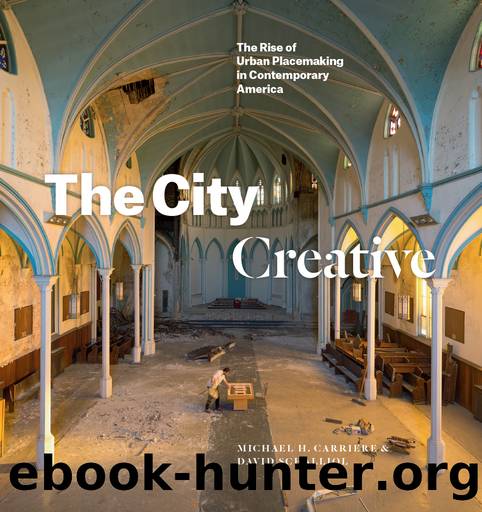The City Creative by Michael H. Carriere & David Schalliol

Author:Michael H. Carriere & David Schalliol [Carriere, Michael H. & Schalliol, David]
Language: eng
Format: epub
Tags: ARC000000 Architecture / General, ARC010000 Architecture / Urban & Land Use Planning, HIS036060 History / United States / 20th Century, SOC026030 Social Science / Sociology / Urban, HIS036070 History / United States / 21st Century, SCI030000 Science / Earth Sciences / Geography
Publisher: The University of Chicago Presss
Published: 2021-04-15T00:00:00+00:00
The Place of Placemaking
The history of urban agriculture in Milwaukee clarifies that the connection between community development and place expressed in contemporary placemaking is and always has been embedded in the issues and organizational actors of the day. Moreover, this historical approach illustrates how current successes and failures of urban agricultureâs intentionally place-based approach to community cohesion, food production, workforce development, and civil rights activism are rooted in this history, a history that looks vastly different from the histories often privileged by placemakers and placemaking organizations in the early twenty-first century. When a guerrilla gardener plants seeds on a derelict lot, she is telling not only the stories of the creative class or the Floridian city but also the broader story of urban engagement by its marginalized residents, often in coordination with small-scale, not-for-profit organizations as well as local, state, and federal governments, all of whom are often written out of the history of contemporary placemaking.
The resulting story is one of direct engagement with the economic and social contributions of siting agriculture in the city amid the dramatic demographic changes that occurred in Milwaukee during the second half of the twentieth century. The reorientation of urban growing followed the already-extant idea of providing healthy food and employment opportunities in underserved communities and combined it with racial and cultural empowerment. The result was new models for interorganizational cooperation in an explicitly racialized and politicized environment. Of course, this counterhistory did not develop in isolation; it existed side by side with the narratives of urban renewal and critiques of such strategies as put forward by the likes of Jane Jacobs, the New Urbanists, Richard Florida, and others concerned about the late twentieth-century city. What is worth stressing here, however, is how such urban agricultural endeavors came to challenge the belief that successful placemaking efforts must take the city as postindustrial for granted. There is a story of consistent urban production on display at such sites, one that draws attention to the relationships between place, labor, and product in ways that push the placemaking conversation away from the creative class and its allies.
The next two chapters of this book will be informed by the lessons gleaned through this thorough examination of urban agriculture in Milwaukee and other cities. As such, they will not devote the same space to the concept of urban agriculture as placemaking or to enumerating contemporary groupsâ historical time lines and contexts. Rather, with a continued emphasis on those often left out of the mainstream placemaking story, we will see how a variety of manufacturers, companies, nonprofit organizations, artists, and activists are rethinking this relationship between place and production in innovative ways. It is in such work that we see a further challengeâindeed, a useful challengeâto the ways creative placemaking has been historicized, articulated, and practiced in the early twenty-first century.
Download
This site does not store any files on its server. We only index and link to content provided by other sites. Please contact the content providers to delete copyright contents if any and email us, we'll remove relevant links or contents immediately.
Kathy Andrews Collection by Kathy Andrews(10505)
The remains of the day by Kazuo Ishiguro(7540)
Spare by Prince Harry The Duke of Sussex(4188)
Paper Towns by Green John(4163)
The Body: A Guide for Occupants by Bill Bryson(3788)
Be in a Treehouse by Pete Nelson(3205)
Harry Potter and the Goblet Of Fire by J.K. Rowling(3023)
Goodbye Paradise(2948)
Never by Ken Follett(2869)
Into Thin Air by Jon Krakauer(2695)
The Remains of the Day by Kazuo Ishiguro(2613)
The Genius of Japanese Carpentry by Azby Brown(2601)
The Cellar by Natasha Preston(2591)
Drawing Shortcuts: Developing Quick Drawing Skills Using Today's Technology by Leggitt Jim(2526)
120 Days of Sodom by Marquis de Sade(2426)
Architecture 101 by Nicole Bridge(2348)
The Man Who Died Twice by Richard Osman(2289)
Machine Learning at Scale with H2O by Gregory Keys | David Whiting(2263)
Fairy Tale by Stephen King(2058)
